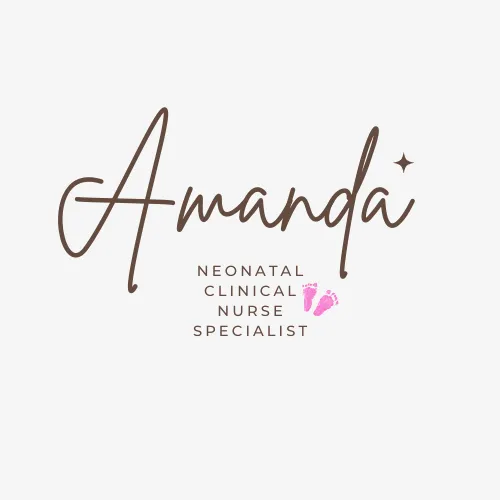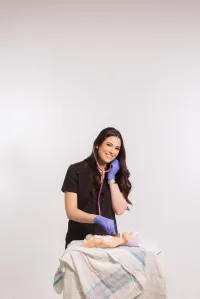
Welcome to Amanda's NICU Education




Hi! My name is Amanda. I'm a NICU nurse, Clinical Nurse Specialist, NICU Educator... basically your NICU BFF. If you want to talk NICU, I'm here for you! I love everything about NICU nursing and I'm eager to learn and share my knowledge with all my NICU friends.
I have been a NICU nurse since 2009 I am currently a Clinical Nurse Specialist in a Level IV NICU in Los Angeles.
I am passionate about educating the next generation of NICU nurses. I share my knowledge through platforms such as Instagram and Facebook and am excited to have you here on my website!
Click on the button below to sign up for my newsletter filled with NICU education and tips for all experience levels.

Not very many people love taking tests but as a self-acclaimed "forever student" who has taken (and passed) five different certification exams I am no longer afraid of tests! "Way to brag", you might be thinking but I want to help YOU pass your certification exam too!
Introducing Amanda's RNC-NIC Success digital course - your ultimate study companion!
Gain unlimited, on-demand access for life, ensuring you're primed to ace your certification exam.
I'm here to help you succeed and I can't wait for you to share with me that you PASSED the RNC-NIC EXAM!!!









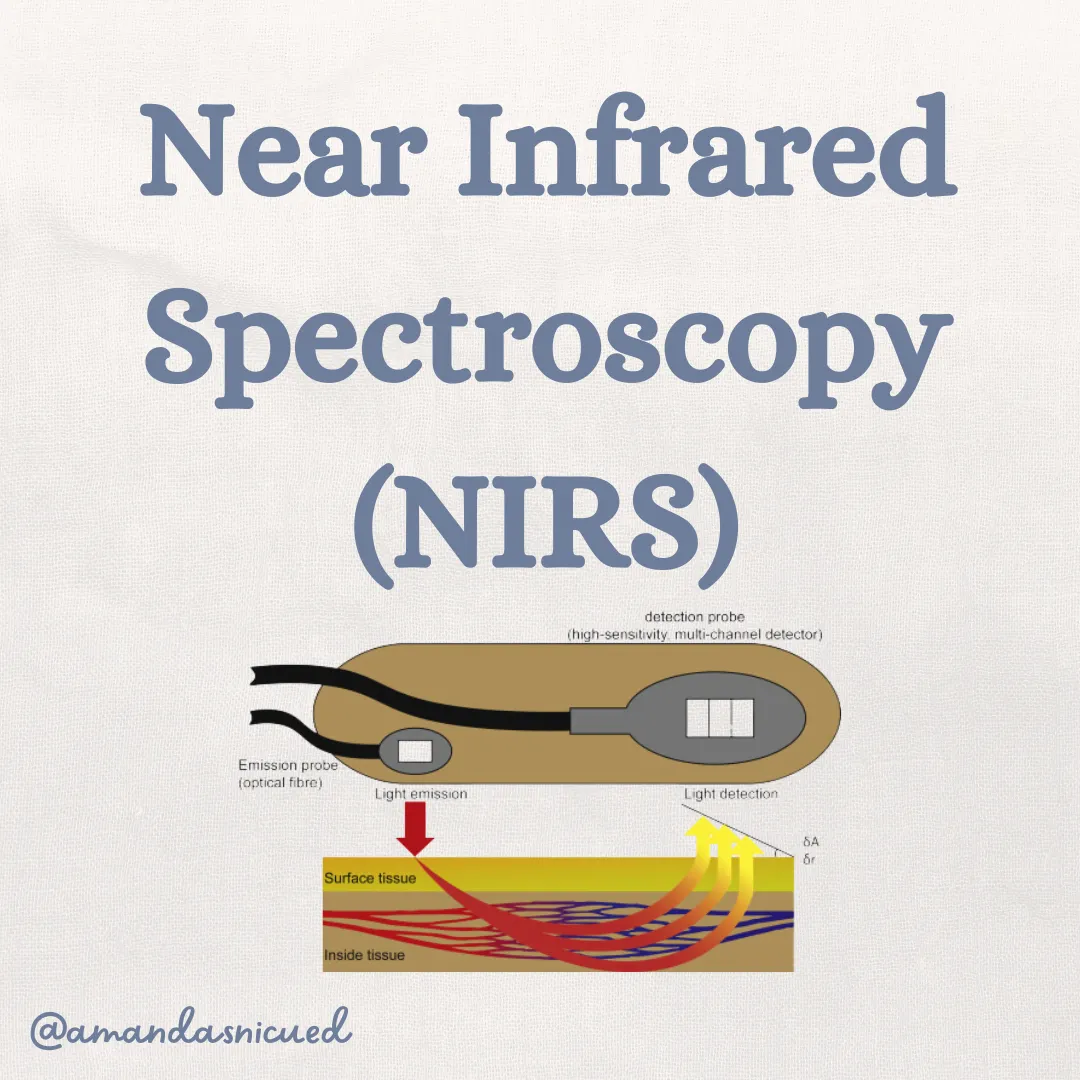
NIRS
Does your NICU utilize NIRS?
Near-infrared spectroscopy (NIRS) is an innovative, non-invasive monitoring technique that is used in many NICUs around the world. Let’s review what NIRS is, how it works, which patients may benefit from it, and what NICU nurses should monitor.

What is NIRS?
Near-infrared spectroscopy (NIRS) is a technique used to monitor the oxygenation and hemodynamics of tissue in real-time. By using near-infrared light, NIRS can measure the oxygen uptake in tissues like the brain, kidneys, and mesentery. This information is helpful for understanding the oxygen supply and consumption, cluing us into the metabolic state of the tissues.
When thinking about NIRS you make be asking, “how is NIRS different from the pulse oximeter?” NIRS and pulse oximetry are both used to monitor oxygenation, but they differ in their applications and the information they provide. Pulse oximetry measures the oxygen saturation of arterial blood, providing a snapshot of overall oxygen levels in the blood. It uses red and infrared light to detect changes in blood oxygenation. NIRS is different in that it monitors the oxygenation and hemodynamics of specific tissues. This technique measures the balance between oxygenated and deoxygenated hemoglobin in the tissues, giving a more localized and detailed picture of tissue oxygenation.
How Does NIRS Monitoring Work?
NIRS monitoring works by using near-infrared light to measure the oxygenation levels in tissues. Sensors are placed on specific body areas like the forehead or flank, emitting near-infrared light into the tissues. This light is absorbed by hemoglobin, with the sensors detecting the reflected light. Since oxygenated and deoxygenated hemoglobin absorb light differently, the device can calculate oxygenation levels. These oxygenation levels provide us with information about how much oxygen uptake is occurring at the tissue level. These calculations are then displayed in real-time, offering continuous, dynamic monitoring of the infant's oxygenation status for immediate clinical interpretation and action. These levels are trended and used in context of the babies clinical situation.
Which Patients May Benefit from NIRS Monitoring?
NIRS monitoring is particularly beneficial many patients in the NICU:
1. Preterm Infants: These infants are at a higher risk of cerebral injury and other complications due to their underdeveloped organs, fragile vessels, and poorly developed autoregulation of cerebral blood flow. NIRS can help in closely monitor brain oxygenation, theoretically helping us to detect and prevent injury. NIRS has also been used to study the hemodynamic changes associated with the development of NEC.
2. Infants with Congenital Heart Disease: These babies have compromised hemodynamics and oxygen delivery. NIRS helps in assessing the effect of surgical and medical interventions, ensuring that the brain and other vital organs are receiving adequate oxygen.
3. Babies with Hypoxic-Ischemic Encephalopathy (HIE): For infants who have suffered from a lack of oxygen at birth, NIRS provides critical data on brain and kidney injury.
4. Surgical Patients: Infants undergoing or recovering from surgery can be monitored for adequate tissue perfusion and oxygenation. NIRS can help detect potential complications early, such as poor blood flow or oxygen delivery.
5. Infants with Sepsis or Shock: NIRS can be used to monitor tissue oxygenation in infants with severe infections or shock, providing early warning signs of deteriorating conditions and guiding interventions.
What Should NICU Nurses Monitor in Babies Undergoing NIRS Monitoring?
When caring for infants with NIRS monitoring, NICU nurses need to be vigilant about several key aspects. First, understanding the normal baseline values for each patient is crucial for identifying significant changes. Normal NIRS values are:
Cerebral 65-85%
Renal: 75-95% in term babies and 65-85% in preterm babies
Mesenteric: 65-85% in term babies, preterm babies can have variable normals
Continuous monitoring allows for the detection of gradual or sudden changes in tissue oxygenation, which could indicate underlying issues. Correlating NIRS data with other monitoring systems provides a comprehensive picture of the infant's status. For example, if the baby you are caring for has a pulse oximetry of 95% and a cerebral saturation of 75% on NIRS, that tells us the baby is extracting 20% of the oxygen from the hemoglobin (a normal finding). If the pulse oximetry is 95% and the cerebral NIRS is 40%, that's not normal... something is wrong requiring investigation.
What does it mean if the NIRS is too high or too low??
There are many factors that can be associated with low readings. Hypocarbia is related to cerebral vasoconstriction which can reduce blood flow to end organs, which can decrease NIRS. Other neonatal issues like hemodynamically significant PDA and IVH can affect hemodynamics, therefore affecting NIRS results. In addition, if there is low oxygen carrying capacity (i.e. anemia) we could also see low NIRS.
NIRS values that are high can occur as well. Some factors that can cause high NIRS readings include hyperoxia, hypercarbia, hypoglycemia, and hypertension. Increased perfusion can result in increased NIRS values. Another problem that can cause increased NIRS values include decreased oxygen consumption at the tissue level. This is concerning for injury to that tissue.
Of course we may also see fluctuations with our overall care (e.g. positioning, suctioning, etc.) or artifact can occur if the sensor is not secured appropriately. As with any other device it is important we are mindful of proper skin care to ensure we are achieving reliable readings and preventing injury. Ensuring proper sensor placement and checking skin integrity regularly helps prevent pressure injury. Nurses can use transparent dressings or skin prep to protect the skin. In addition, the probe should be repositioned based on your hospitals policies and procedures to prevent skin injury.
Verifying appropriate alarm thresholds is essential for timely interventions, and interpreting NIRS readings in the context of the infant's overall clinical picture, including gestational age and underlying conditions, is critical for accurate assessment and care. Discuss the NIRS trends along with other aspects of the clinical condition with the interdisciplinary team to identify causes for concerns and potential interventions.
Use Code Amanda10 for 10% off the NIRS Workshop

NIRS monitoring is a powerful tool in the NICU that offers valuable insights into the oxygenation status of our most vulnerable patients.
Do you use NIRS in your NICU?
Learn more about NIRS from Synapse Care Solutions and the Neonatal NIRS Consortium.
If you're just starting out with NIRS, check out this great talk from my friend Katie, "Establishing a NIRS Monitoring Program in the NICU"
Amanda xoxo
Missed my other newsletters? Click here to read them!
Let's Study Together! Join my Certification Course
References:
de Vries, L., Volpe, J. (2025). Specialized Neurologic Studies in Volpe's Neurology of the Newborn (7th Ed)
Randall, K. (2021). What is NIRS and how should we use it in the NICU? Retrieved from https://www.linkedin.com/pulse/what-nirs-how-should-we-use-nicu-kathi-randall-rn-nnp
Pavlek, L. R., Mueller, C., Jebbia, M. R., Kielt, M. J., & Fathi, O. (2021). Near-Infrared Spectroscopy in Extremely Preterm Infants. Frontiers in pediatrics, 8, 624113. https://doi.org/10.3389/fped.2020.624113
Wolfsberger CH, Schwaberger B, Urlesberger B, et al. Reference Ranges for Arterial Oxygen Saturation, Heart Rate, and Cerebral Oxygen Saturation during Immediate Postnatal Transition in Neonates Born Extremely or Very Preterm. J Pediatr. Published online May 31, 2024. doi:10.1016/j.jpeds.2024.114132

December 2023 Certification Review Webinar
NICU Certification Review


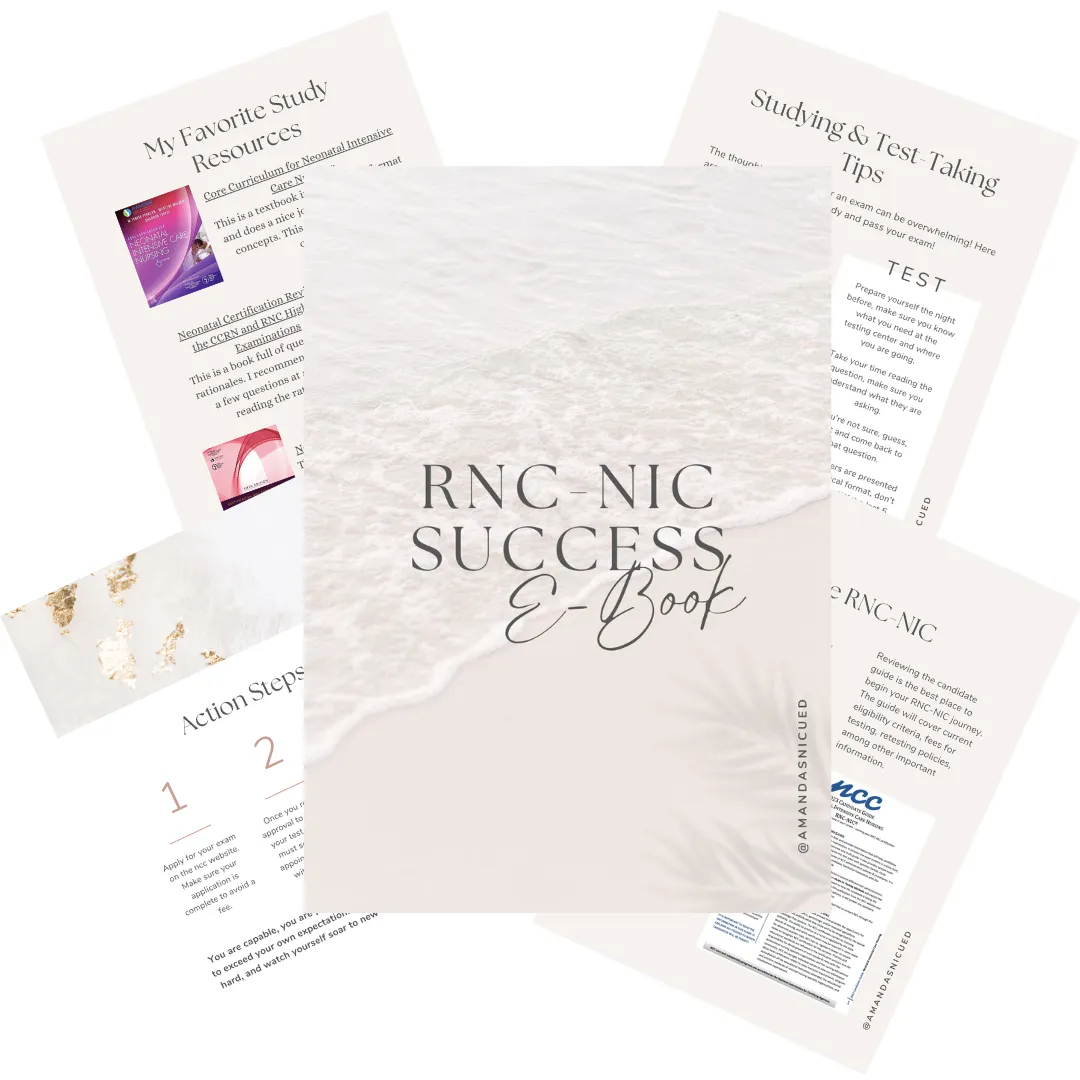
Ready to kickstart your journey to becoming a certified NICU nurse?
Look no further!
Grab my FREE E-Book packed with essential study and test-taking strategies for the RNC-NIC.
In the E-Book I give you the resources you need including the link to access the candidate guide, several types of books to study from, some of my favorite strategies, an outline of the content you should review, and a blank calendar for you to make your study plan!
Frequently Asked Questions About the RNC-NIC exam

What is the RNC-NIC?
The RNC-NIC is a competency-based exam that tests the specialty knowledge of nurses in the United States & Canada who care for critically ill newborns and their families.
The RNC-NICU is a nationally recognized certification that recognizes the registered nurse for their specialty knowledge and skill.
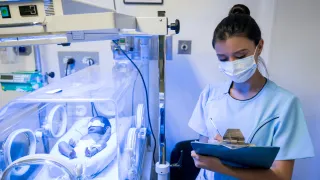
Who can take the RNC-NIC exam?
Nurses can take this exam after a minimum of two years experience in the NICU caring for critically ill newborns and their families.

Which books should I use?
I'm glad you asked! There are many excellent books to help you prepare for the RNC-NIC, I gathered ande describe each of them for you in my FREE e-book.
Is there a course to help me study?
Yes! Many hospitals host their own certification course and there are a few online courses. See my RNC-NIC test taking tips E Book for more information
What happens if I don't pass the exam?
If you don't pass the exam on your first try you can try again after 90 days. You will have to reapply after 90 days and pay a retest fee. There is no limit to the number of times you can take the exam (however a candidate can only sit for the exam twice per year).

Can I make more money if I take the RNC-NIC exam and get certified?
Yes! Many hospitals provide a raise or a bonus for nurses with specialty certifications. Hospitals also typically hire at a higher base salary when nurses have a certification.

Find me @amandasnicued on these channels or Email me
hey nurses don't miss out
© Copyright 2024. AmandasNICUEd. All rights reserved. | Terms & Conditions | Privacy Policy Contact: [email protected]
